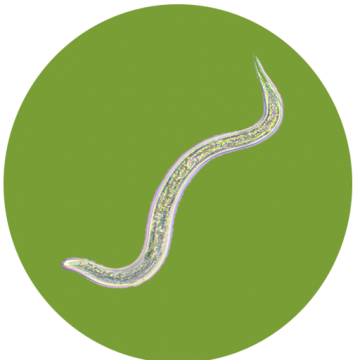
A major focus of research in my lab has been directed at understanding the mechanism of CLE peptide mimicry in cyst nematode parasitism of plants. CLAVATA3/ESR (CLE) is a class of plant peptide hormones known to play important roles in controlling the fate of stem cells in the growing zones of the plant. Since the first discovery of a soybean cyst nematode (SCN; Heterodera glycines) effector protein that functioned as a mimic of plant CLE peptides (HgCLE) (representing the first time CLE peptides had been identified in any organism outside of the plant kingdom; see Mitchum et al, Annu. Rev. Phytopathol. 2012. 50:175–95 for overview), my research program has sought to fill gaps in our knowledge of how cyst nematodes use CLE peptides to modulate plant developmental programs to form feeding sites and, in turn, translate these findings into novel strategies to bioengineer crops with robust resistance to cyst nematodes. Through the years, we’ve partnered with several plant biologists around the world to extend our understanding of how plant-parasitic nematodes developmentally reprogram their hosts to cause disease.
Current work is focused on investigating how nematodes use peptide hormone mimicry to co-opt aspects of the vascular stem cell pathway, exploring a unique trafficking function in CLE effector mimics, and determining how different types and combinations of plant peptide hormone effector mimics among plant-parasitic nematodes shape host-range and nematode feeding site formation. In addition, we have identified receptor proteins of nematode secreted CLE peptides in Arabidopsis and extended these findings to crop plants. We are currently advancing patented technology directed at inhibiting the plant receptors of nematode CLE peptides for cyst nematode control.
Related Publications:
Gheysen G and Mitchum MG. Phytoparasitic nematode control of plant hormone pathways. Plant Physiology 2019;179(4):1212-1226, Focus Issue on Biotic Stress https://doi.org/10.1104/pp.18.01067
Guo X, Wang J, Gardner M, Fukuda H, Kondo Y, Etchells P, Wang X, and Mitchum MG. Identification of cyst nematode B-type CLE peptides and modulation of the vascular stem cell pathway for feeding cell formation. PLOS Pathogens 2017: 13(2):e1006142. https://doi.org/10.1371/journal.pone.0171514
Dowd CD, Chronis D, Radakovic ZS, Siddique S, Schmulling T, Werner T, Kakimoto T, Grundler FMW, Mitchum MG. Divergent expression of cytokinin biosynthesis, signaling and catabolism genes underlying differences in feeding sites induced by cyst and root-knot nematodes. The Plant Journal 2017; 92:211-228. https://doi.org/10.1111/tpj.13647
Siddique S, Radakovic ZS, De La Torre CM, Chronis D, Holbein J, Novak O, Matera C, Hutten M, Gutbrod P, Anjam MS, Rozanska E, Habbash S, Elashry AN, Sobczak M, Strnad M, Kakimoto T, Schmulling T, Mitchum MG, Grundler F. A plant-parasitic nematode releases cytokinins that control cell division and orchestrate feeding-site formation in host plants. Proceedings of the National Academy of Sciences 2015;112(41):12669-74 https://doi.org/10.1073/pnas.1503657112
Guo X, Chronis D, De La Torre Cuba CM, Smeda J, Wang X, Mitchum MG. Enhanced resistance to soybean cyst nematode Heterodera glycines in transgenic soybean by silencing putative CLE receptors. Plant Biotechnology Journal 2015;13(6):801-10. https://doi.org/10.1111/pbi.12313
Chen S, Lang P, Chronis D, Zhang S, De Jong WS, Mitchum MG, Wang X. In planta processing and glycosylation of a nematode CLE effector and its interaction with a host CLV2-like receptor to promote parasitism. Plant Physiology 2015 167;262-272. https://doi.org/10.1104/pp.114.251637
Replogle A, Wang J, Paolillo V, Smeda J, Kinoshita A, Durbak A, Tax FE, Wang X, Sawa S, and Mitchum MG. Synergistic interaction of CLAVATA1, CLAVATA2, and RECEPTOR-LIKE PROTEIN KINASE 2 in cyst nematode parasitism of Arabidopsis. Molecular Plant-Microbe Interactions 2013;26(1):87-96. https://doi.org/10.1094/MPMI-05-12-0118-FI
Mitchum MG, Wang X, Wang J, and Davis EL. The role of peptides and other small molecules in nematode parasitism. Annual Review of Phytopathology 2012;50:175-195. https://doi.org/10.1146/annurev-phyto-081211-173008
Gheysen G and Mitchum MG. How nematodes manipulate plant development pathways for infection. Current Opinion in Plant Biology 2011;14:1-7. https://doi.org/10.1016/j.pbi.2011.03.012
Replogle A, Wang J, Bleckmann A, Hussey RS, Baum TJ, Shinichiro S, Davis EL, Wang X, Simon R, and Mitchum MG. Nematode CLE signaling in Arabidopsis requires CLAVATA2 and CORYNE. The Plant Journal 2011;65(3):430-440. https://doi.org/10.1111/j.1365-313X.2010.04433.x
Wang J, Replogle A, Hussey R, Baum T, Wang X, Davis EL, and Mitchum MG. Identification of potential host plant mimics of CLV3/ESR (CLE)-like peptides from the plant-parasitic nematode Heterodera schachtii. Molecular Plant Pathology 2011;12(2):177-186. https://doi.org/10.1111/j.1364-3703.2010.00660.x
Wang J, Joshi S, Korkin D, and Mitchum MG. Variable domain I of nematode CLEs directs post-translational targeting of CLE peptides to the extracellular space. Plant Signaling and Behavior 2010;5(12):1-3. https://doi.org/10.4161/psb.5.12.13774
Wang J, Lee C, Replogle A, Joshi S, Korkin D, Hussey R, Baum TJ, Davis EL, Wang X and Mitchum MG. Dual roles for the variable domain in protein trafficking and host-specific recognition of Heterodera glycines CLE effector proteins. New Phytologist 2010;187(4):1003-1017. https://doi.org/10.1111/j.1469-8137.2010.03300.x
Lu SW, Chen S, Wang J, Yu H, Chronis D, Mitchum MG and Wang X. Structural and functional diversity of CLAVATA3/ESR (CLE)-like genes from the potato cyst nematode Globodera rostochiensis. Molecular Plant-Microbe Interactions 2009;22(9):1128-1142. https://doi.org/10.1094/MPMI-22-9-1128
Gheysen G and Mitchum MG. Molecular insights in the susceptible plant response to nematode infection. IN: RH Berg and CG Taylor (Eds.), Cell Biology of Plant Nematode Parasitism (pp. 45-82). Plant cell monographs, 15. Berlin: Springer, 2009. https://link.springer.com/chapter/10.1007/978-3-540-85215-5_3
Mitchum MG, Wang X and Davis EL. Diverse and conserved roles of CLE peptides. Current Opinion in Plant Biology 2008;11(1):75-81. https://doi.org/10.1016/j.pbi.2007.10.010
Wang X, Mitchum MG, Gao B, Li C, Diab H, Baum TJ, Hussey RS and Davis EL. A parasitism gene from a plant-parasitic nematode with function similar to CLAVATA3/ESR (CLE) of Arabidopsis thaliana. Molecular Plant Pathology 2005;6(2):187-191. https://doi.org/10.1111/j.1364-3703.2005.00270.x
Wang X, Allen R, Ding X, Goellner M, Maier T, De Boer J, Baum T, Hussey R, and Davis EL. Signal peptide-selection of cDNA cloned directly from the esophageal gland cells of the soybean cyst nematode Heterodera glycines. Molecular Plant-Microbe Interactions 2001; 14:536-544. https://doi.org/10.1094/MPMI.2001.14.4.536
Goellner M, Smant G, De Boer JM, Baum TJ, and Davis EL. Isolation of β-1,4-endoglucanase genes from Globodera tabacum and their expression during parasitism. Journal of Nematology 2000; 32(2):154-165. https://www.ncbi.nlm.nih.gov/pmc/articles/PMC2620441/
